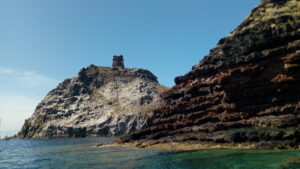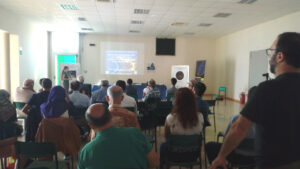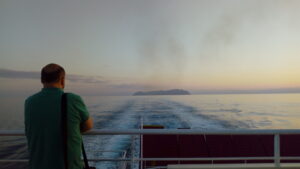From the two-day meeting in a small Tuscan island, an invitation to think twice before you install your next lamp, to reduce its negative impacts and to make space for opportunities in tourism, especially in rural areas.
 In the stunning setting of the island of Capraia, in the Tuscan archipelago, a symposium was held on September 13 and 14 2018 on the topic of protection and promotion of night sky. The event was organized by the National Research Council’s Institute of Biometeorology in collaboration with the University of Pisa, the BuioMetria Partecipativa project, and fondazione Clima e Sostenibilità, with patronage by Regione Toscana, Comune di Capraia Isola, the associazione Osservatori Meteorologici Storici Italiani and partial funding by the Stars4all European project.
In the stunning setting of the island of Capraia, in the Tuscan archipelago, a symposium was held on September 13 and 14 2018 on the topic of protection and promotion of night sky. The event was organized by the National Research Council’s Institute of Biometeorology in collaboration with the University of Pisa, the BuioMetria Partecipativa project, and fondazione Clima e Sostenibilità, with patronage by Regione Toscana, Comune di Capraia Isola, the associazione Osservatori Meteorologici Storici Italiani and partial funding by the Stars4all European project.
The topics addressed covered technical aspects of night sky quality measurement, the development of innovative sensors, the impact of light pollution in ecology, outreach and citizen science initiatives, and case of integrated promotion of territories. While some of these topics may sound complex, the negative impact of excessive artificial light at night are gradually being acknowledged by a wider audience (in Italy see for example Repubblica 2016, Le Scienze 2017 or Prima dell’Alba, 2018).
The symposium hosted 32 presentations with authors from various Italian regions, as well as Hungary, Spain, Austria, Germany, Turkey, Canada, Malaysia, and South Korea. In fact, this was the first international meeting taking place in Italy on these topics since more than fifteen years.
During the two days an interesting array of expertise showcased its views. These included long-term experiences by well known authorities in the field of light pollution research, as well as groups that started just recently to address this topic, but have a relevant role in environmental field.
From the symposium website you may donwload the abstracts of the presentation, with author contact information to learn more about the topics discussed.
Next to the symposium, night-time activities were planned, with observations and measurements complementing the surveys conducted since 2017 by CNR IBIMET, University of Pisa and BuioMetria Partecipativa project.
Last but not least, on the evening of Friday, Sep. 14, an after-dark excursion led by guide of the Tuscan Archipelago National Park was proposed to symposium participants as well as tourists on the island, providing an interesting outreach moment linked to the symposium.

The possibility of hosting multiple experts from abroad helped us to see from a different perspective some of the critical issues related in Italy to the excess of lighting in many parts of its territory, as well as to acknowledge the opportunities deriving from night sky promotion for tourism and environmental education.
Our wish is that the symposium, in addition to helping to provide a view on the state of the art on promotion and protection of night skies may encourage public and private stakeholders related to lighting, so that they may keep in greater account in new installations the indications which are gradually being consolidated by scientists. Namely we should bear in mind the negative effects of the blue component in artificial lighting, and the containment of light to areas and hours of the day where it is really needed to insure our safety and the quality of urban environments.
Upcoming events on the same topic:
- Marrakesh, Morocco 22-26 Oct. 2018, Atlas Dark Sky
- Salt Lake City, USA, 12-14 Nov. 2018 Fifth “Artificial Light at Night” conference
- Zselic Valley, Hungary , 25-28 June 2019, Fourth “Light Pollution Theory, Modelling, and Measurement” conference
For more information: info@pibinko.org

